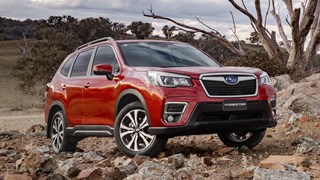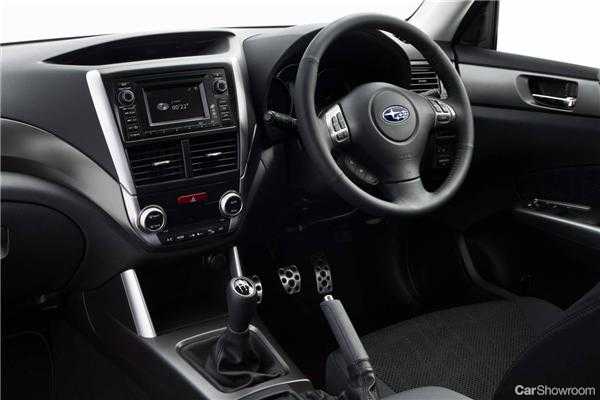In most market segments in which it competes, Toyota is number one – but not compact SUVs where Australian buyers prefer the Subaru Forester ahead of Toyota’s RAV.
For Subaru, the Forester delivers a smaller overall dimension than the RAV (less intimidating for female and first-time SUV buyers), the choice of a diesel engine (now about 20 per cent of Subaru Forester sales) and – across the range – a pricing advantage.
Want to know which Subaru Forester is best for you? Well read on because here at Car Showroom we’ve just had three weeks in three Foresters back-to-back – X, S and Diesel.
Subaru Forester Overview
Not the absolute newest design in the car park, Subaru’s Forester is a five-door/five-seat all-wheel-drive compact SUV. In many ways it was Subaru’s push into North America which spawned the Forester as buyers there demanded ‘Crossover’ vehicles to fight rising gas prices while still providing the space families need.
Now into its third model generation, the Subaru Forester has carved a very successful niche for the brand in Australia. It’s small enough that mums can easily park at school, yet sufficiently spacious to take the whole family on holidays and tough/equipped enough to handle all but the roughest outback dirt tracks.
With Subaru high-tech, quality and safety obvious wherever you look, the Forester is Subaru at its best…well apart from the Impreza WRX STi Spec R (which history will show as one of the greatest mass-produced performance cars ever).
Subaru Forester The Engines
One word for engine design - ‘Boxer’ - and you know you’re talking Subaru. Lots of performance from a compact package size makes sense for today’s automotive market and Subaru’s engine team has the boxer lineup in tip-top shape.
We tested the Subaru Forester X (2.5-litre, naturally-aspirated, 126kW at 5,800rpm/235Nm at 4,100rpm); Subaru Forester S (WRX engine – 2.5-litre turbocharged, 193kW at 6,000rpm/347Nm at 2,800rpm) and Subaru Forester diesel (2.0-litre, turbocharged, 108kW at 3,600rpm/350Nm from 1800-2,400rpm).
All drive all four wheels in different ways. The entry-level Subaru Forester X has Active Torque Spilt from a center differential with a viscous limited slip differential, while the S has Variable Torque Distribution and the diesel makes do with a constant center differential with a viscous limited slip differential.
Fuel consumption (combined cycle) ranges from 6.4l/100kms for the Subaru Forester diesel through 9.3l/100kms for the Subaru Forster X to 10.5l/100kms for the Subaru Forester S.
Of all the Subaru Forester models, the ‘Premium’ diesel version affords the best towing capacity – 1595kgs.
Subaru Forester Interior
There’s lots to like about the interior of all Subaru Forester models but overall we had to shave just a little from the score because some of the plastic trim is below par for touch/feel/tactile elements compared to some rivals.
Instrumentation is the usual Subaru high standard, the steering wheel adjusts for rake and reach (not all in this segment offer that comfort/safety feature) and the S model adds sports pedals and paddle shifters for manual gear changes.
Subaru Forester X misses-out on a leather-wrapped steering wheel and S versions gain nice leather for their seats.
On the audio front, Subaru Forester X runs a four-speaker CD/MP3/WMA/USB system while S gains a multi-function screen, extra speakers and satellite navigation.
But here’s the crux of the matter for families – all Subaru Forester models deliver great rear seat space and cargo capacity of 450-litres (rear seat in place) up to 1,660-litres (rear seat folded).
Subaru Forester Exterior & Styling
We have to rank the Subaru Forester highly in this department for the same reason Aussie families have voted it number one with their hip pockets. Subaru Forester is unquestionably a very smart, well-sized design that’s just right for its demographic – female and first time family buyers.
Compared to earlier models, the latest generation Subaru Forester is a much more sophisticated design with quite complex curves around thre window line, wheel arches, front grille and tailgate.
Combine those large side windows and windscreen and all-round visibility is generally good – juts a little restricted in rear three-quarter by the rising beltline.
Like all wagons, rear visibility is a tad tough, but the available rear-view camera in Subaru Forester fixes that in one step.
Subaru Forester X runs on 16-inch steel wheels, Subaru Forester S gains the 17-inch five-spoke alloy wheels for the WRX while Subaru Forster diesel sits on 16-inch or 17-inch alloys (depending on the model).
Subaru Forester On The Road
Despite its usual Subaru high quality all-paw grip, some newer rivals – Kia Sportage and Volkswagen Tiguan - have overtaken the Forester for chassis dynamics. Sure the Subaru Forester remains wonderfully balanced and refined, but it’s no longer at the front of the pack for precision and sharpness (although some would argue those aren’t key attributes desired by buyers in this segment).
We’re not talking deal-breakers here – it’s just over our high-speed mountain roads test route, we didn’t find the Subaru Forester models quite as responsive to steering wheel input and throttle changes as say their Kia and Volkswagen rivals.
However, it must be said the 193kW/347Nm of the Subaru Forester S completely overshadows the best of Sportage and Tiguan, providing the sort of performance enthusiast-driver dads will enjoy when they get behind the wheel.
And the 108kW/350Nm turbo-diesel Subaru Forester doesn’t hang around either – nicely responsive with handy acceleration through its manual six-speed transmission.
The entry-level Subaru Forester X was powered by Subaru’s naturally aspirated 2.5-litre 126kW/235Nm engine. Tipping the scales at 1475kgs, the base model Forester needed precise gear selection to be at its best for rapid overtaking or freeway merging and probably didn’t match the segment’s best for noise isolation.
Subaru Forester Challenges
We have no idea when there will be an all-new Forester (it’s not on the horizon) - but we reckon Subaru would be putting its interior designers and chassis engineers under the pump because its just small items in those areas where the current Forester shows any weakness.
An automatic transmission for the Subaru Forester 2.0D would be desirable too.
Subaru Forester Verdict
We’ve long been fans of the Subaru Forester and these three weeks back-to-back confirmed our thoughts. Nice size, well equipped, ideal for females (the predominant drivers in this segment) and first-time SUV buyers…the Forester succeeds and is the segment’s bestseller for lots of common-sense reasons.
And Subaru’s acknowledged build quality/reliability reputation score highly too.
If you can stretch the extra coin to $50,990, the Subaru Forester S is a pearler – the sporty extras tick our boxes - and the extra grunt of the 193kW/347Nm version of Subaru’s 2.5-litre turbo takes this wagon into ‘Superwagon’ territory.
Good as the entry-level Forester X is, it’s $30,990 sticker is challenged by the well-equipped SLi model Kia Sportage ($31,990). But if interior space is crucial for you, the Subaru still has its nose in front.
Subaru Forester The Competition
Kia Sportage is a Car Showroom favourite in this segment. The Sportage – in company with other newer designs like the Hyundai ix35, Nissan Dualis and Volkswagen Tiguan – has readjusted the benchmarks for refinement and chassis dynamics.
Toyota’s RAV rivals the Subaru Forester as the sales leader because it’s good…and better off-road.
Holden Captiva, Honda CRV, Mazda CX-7, Mitsubishi Outlander/ASX and even the updated Skoda Octavia Scout should also be in your consideration set.
Another consideration may be how quickly you need to take delivery of your new car as we’ve heard tales of extensive waiting lists in this popular market segment.



























